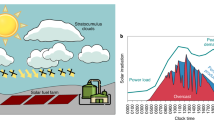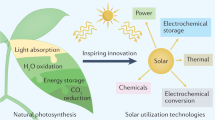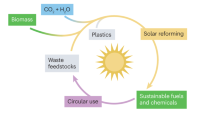Abstract
The synthesis of fuels using sunlight offers a promising sustainable solution for chemical energy storage, but inefficient utilization of the solar spectrum limits its commercial viability. Apart from fundamental improvements to (photo)catalyst materials, solar fuel production systems can also be designed to improve solar energy utilization by integrating complementary technologies that more efficiently utilize the solar spectrum. Here we review recent progress on emerging complementary approaches to better modify, enhance or distribute solar energy for sunlight-to-fuel conversion, including advanced light management, integrated thermal approaches and solar concentrators. These strategies can improve the efficiency and production rates of existing photo(electro)chemical systems and, therefore, the overall economics of solar fuel production. More broadly, the approaches highlight the necessary collaboration between materials science and engineering to help drive the adoption of a sustainable energy economy using existing technologies.
This is a preview of subscription content, access via your institution
Access options
Access Nature and 54 other Nature Portfolio journals
Get Nature+, our best-value online-access subscription
$29.99 / 30 days
cancel any time
Subscribe to this journal
Receive 12 digital issues and online access to articles
$119.00 per year
only $9.92 per issue
Buy this article
- Purchase on Springer Link
- Instant access to full article PDF
Prices may be subject to local taxes which are calculated during checkout






Similar content being viewed by others
References
Kim, J. H., Hansora, D., Sharma, P., Jang, J.-W. & Lee, J. S. Toward practical solar hydrogen production—an artificial photosynthetic leaf-to-farm challenge. Chem. Soc. Rev. 48, 1908–1971 (2019).
Shaner, M. R., Atwater, H. A., Lewis, N. S. & McFarland, E. W. A comparative technoeconomic analysis of renewable hydrogen production using solar energy. Energy Environ. Sci. 9, 2354–2371 (2016).
McKone, J. R., Lewis, N. S. & Gray, H. B. Will solar-driven water-splitting devices see the light of day? Chem. Mater. 26, 407–414 (2014).
Takata, T. et al. Photocatalytic water splitting with a quantum efficiency of almost unity. Nature 581, 411–414 (2020).
Wang, Q. et al. Scalable water splitting on particulate photocatalyst sheets with a solar-to-hydrogen energy conversion efficiency exceeding 1%. Nat. Mater. 15, 611–615 (2016).
Würfel, P. Thermodynamic limitations to solar energy conversion. Physica E 14, 18–26 (2002). Study reporting the thermodynamic analysis and entropy-limited ideal maximum efficiency of the solar energy conversion process
Huang, X., Han, S., Huang, W. & Liu, X. Enhancing solar cell efficiency: the search for luminescent materials as spectral converters. Chem. Soc. Rev. 42, 173–201 (2013).
Shockley, W. & Queisser, H. J. Detailed balance limit of efficiency of p–n junction solar cells. J. Appl. Phys. 32, 510–519 (1961).
Wang, Q. & Domen, K. Particulate photocatalysts for light-driven water splitting: mechanisms, challenges, and design strategies. Chem. Rev. 120, 919–985 (2019).
Wang, Y. et al. Mimicking natural photosynthesis: solar to renewable H2 fuel synthesis by Z-scheme water splitting systems. Chem. Rev. 118, 5201–5241 (2018).
De Vos, A. Detailed balance limit of the efficiency of tandem solar cells. J. Phys. D: Appl. Phys. 13, 839–846 (1980).
Hu, S., Xiang, C., Haussener, S., Berger, A. D. & Lewis, N. S. An analysis of the optimal band gaps of light absorbers in integrated tandem photoelectrochemical water-splitting systems. Energy Environ. Sci. 6, 2984–2993 (2013).
Pan, L. et al. Boosting the performance of Cu2O photocathodes for unassisted solar water splitting devices. Nat. Catal. 1, 412–420 (2018).
Kobayashi, H. et al. Development of highly efficient CuIn0.5Ga0.5Se2-based photocathode and application to overall solar driven water splitting. Energy Environ. Sci. 11, 3003–3009 (2018).
Cheng, W.-H. et al. Monolithic photoelectrochemical device for direct water splitting with 19% efficiency. ACS Energy Lett. 3, 1795–1800 (2018).
Bolton, J. R., Strickler, S. J. & Connolly, J. S. Limiting and realizable efficiencies of solar photolysis of water. Nature 316, 495–500 (1985).
Mojiri, A., Taylor, R., Thomsen, E. & Rosengarten, G. Spectral beam splitting for efficient conversion of solar energy—a review. Renew. Sust. Energy Rev. 28, 654–663 (2013).
Acar, C. & Dincer, I. Enhanced generation of hydrogen, power, and heat with a novel integrated photoelectrochemical system. Int. J. Hydrog. Energy 45, 34666–3467 (2020).
Qiu, Y. et al. Efficient solar-driven water splitting by nanocone BiVO4–perovskite tandem cells. Sci. Adv. 2, e1501764 (2016).
Skoplaki, E. & Palyvos, J. A. On the temperature dependence of photovoltaic module electrical performance: a review of efficiency/power correlations. Sol. Energy 83, 614–624 (2009).
Imenes, A. G., Buie, D. & McKenzie, D. The design of broadband, wide-angle interference filters for solar concentrating systems. Sol. Energy Mater. Sol. Cells 90, 1579–1606 (2006).
Na, S.-I. et al. Efficient polymer solar cells with surface relief gratings fabricated by simple soft lithography. Adv. Funct. Mater. 18, 3956–3963 (2008).
Zeng, L. et al. Demonstration of enhanced absorption in thin film Si solar cells with textured photonic crystal back reflector. Appl. Phys. Lett. 93, 221105 (2008).
Mokkapati, S. & Catchpole, K. R. Nanophotonic light trapping in solar cells. J. Appl. Phys. 112, 101101 (2012).
Shi, X. et al. Unassisted photoelectrochemical water splitting exceeding 7% solar-to-hydrogen conversion efficiency using photon recycling. Nat. Commun. 7, 11943 (2016). Light management enhanced photocurrent generation for photoelectrochemical water splitting using a distributed Bragg reflector
Rao, A. & Friend, R. H. Harnessing singlet exciton fission to break the Shockley–Queisser limit. Nat. Rev. Mater. 2, 17063 (2017).
Smith, M. B. & Michl, J. Singlet fission. Chem. Rev. 110, 6891–6936 (2010).
Tayebjee, M. J., Rao, A. & Schmidt, T. All-optical augmentation of solar cells using a combination of up- and downconversion. J. Photon. Energy 8, 022007 (2018). A detailed study on the effects of up- and downconversion on the theoretical maximum efficiency of solar cells
Tayebjee, M. J. Y., Gray-Weale, A. A. & Schmidt, T. W. Thermodynamic limit of exciton fission solar cell efficiency. J. Phys. Chem. Lett. 3, 2749–2754 (2012).
Hovel, H. J., Hodgson, R. T. & Woodall, J. M. The effect of fluorescent wavelength shifting on solar cell spectral response. Sol. Energy Mater. 2, 19–29 (1979).
Wen, S. et al. Future and challenges for hybrid upconversion nanosystems. Nat. Photon. 13, 828–838 (2019).
Rahaman, M. et al. Selective CO production from aqueous CO2 using a Cu96In4 catalyst and its integration into a bias-free solar perovskite–BiVO4 tandem device. Energy Environ. Sci. 13, 3536–3543 (2020).
Choi, D., Nam, S. K., Kim, K. & Moon, J. H. Enhanced photoelectrochemical water splitting through bismuth vanadate with a photon upconversion luminescent reflector. Angew. Chem. Int. Ed. 58, 6891–6895 (2019). A demonstration of combined up- and downconversion to increase the efficiency of photoelectrochemical water splitting.
Trupke, T., Green, M. & Würfel, P. Improving solar cell efficiencies by up-conversion of sub-band-gap light. J. Appl. Phys. 92, 4117–4122 (2002).
Zhang, M. et al. Improving hematite’s solar water splitting efficiency by incorporating rare-earth upconversion nanomaterials. J. Phys. Chem. Lett. 3, 3188–3192 (2012).
Wang, X. et al. Dye-sensitized lanthanide-doped upconversion nanoparticles. Chem. Soc. Rev. 46, 4150–4167 (2017).
Singh-Rachford, T. N. & Castellano, F. N. Photon upconversion based on sensitized triplet–triplet annihilation. Coord. Chem. Rev. 254, 2560–2573 (2010).
Gholizadeh, E. M. et al. Photochemical upconversion of near-infrared light from below the silicon bandgap. Nat. Photon. 14, 585–590 (2020).
Kim, J.-H. & Kim, J.-H. Encapsulated triplet–triplet annihilation-based upconversion in the aqueous phase for sub-band-gap semiconductor photocatalysis. J. Am. Chem. Soc. 134, 17478–17481 (2012).
Kroupa, D. M., Roh, J. Y., Milstein, T. J., Creutz, S. E. & Gamelin, D. R. Quantum-cutting ytterbium-doped CsPb(Cl1 – xBrx)3 perovskite thin films with photoluminescence quantum yields over 190%. ACS Energy Lett. 3, 2390–2395 (2018).
Romero, M. & Steinfeld, A. Concentrating solar thermal power and thermochemical fuels. Energy Environ. Sci. 5, 9234–9245 (2012).
Fraas, L. M. & Partain, L. D. Solar Cells and Their Applications 2nd edn (Wiley, 2010).
Green, M. A. & Bremner, S. P. Energy conversion approaches and materials for high-efficiency photovoltaics. Nat. Mater. 16, 23–34 (2017).
Jia, J. et al. Solar water splitting by photovoltaic-electrolysis with a solar-to-hydrogen efficiency over 30%. Nat. Commun. 7, 13237 (2016). A record demonstration of \({{{\boldsymbol{\eta}}_{{\mathbf{H}}_{\bf 2}}}}\) efficiency achieved by solar PV–electrolysis under 42 suns concentrated irradiation
Geisz, J. F. et al. Six-junction III–V solar cells with 47.1% conversion efficiency under 143 Suns concentration. Nat. Energy 5, 326–335 (2020).
Rodriguez, C. A., Modestino, M. A., Psaltis, D. & Moser, C. Design and cost considerations for practical solar–hydrogen generators. Energy Environ. Sci. 7, 3828–3835 (2014).
Holmes-Gentle, I., Tembhurne, S., Suter, C. & Haussener, S. Dynamic system modeling of thermally-integrated concentrated PV–electrolysis. Int. J. Hydrog. Energy 46, 10666–10681 (2021).
Khan, M., Shankiti, I., Ziani, A., Wehbe, N. & Idriss, H. A stable integrated photoelectrochemical reactor for H2 production from water attains a solar‐to‐hydrogen efficiency of 18% at 15 suns and 13% at 207 suns. Angew. Chem. Int. Ed. 59, 14802–14808 (2020).
Uekert, T., Pichler, C. M., Schubert, T. & Reisner, E. Solar-driven reforming of solid waste for a sustainable future. Nat. Sustain. 4, 383–391 (2021).
Castedo, A., Casanovas, A., Angurell, I., Soler, L. & Llorca, J. Effect of temperature on the gas-phase photocatalytic H2 generation using microreactors under UVA and sunlight irradiation. Fuel 222, 327–333 (2018).
Castedo, A., Uriz, I., Soler, L., Gandía, L. M. & Llorca, J. Kinetic analysis and CFD simulations of the photocatalytic production of hydrogen in silicone microreactors from water–ethanol mixtures. Appl. Catal. B 203, 210–217 (2017).
Wei, Q. et al. Direct solar photocatalytic hydrogen generation with CPC photoreactors: system development. Sol. Energy 153, 215–223 (2017). A demonstration of a scalable photocatalytic hydrogen production system under concentrated solar irradiation from compound parabolic collectors
Apostoleris, H., Stefancich, M. & Chiesa, M. Tracking-integrated systems for concentrating photovoltaics. Nat. Energy 1, 16018 (2016).
Chueh, W. C. et al. High-flux solar-driven thermochemical dissociation of CO2 and H2O using nonstoichiometric ceria. Science 330, 1797–1801 (2010). A demonstration of two-step, solar-driven thermochemical production of fuels
Steinfeld, A. Solar thermochemical production of hydrogen––a review. Sol. Energy 78, 603–615 (2005).
Muhich, C. L. et al. Efficient generation of H2 by splitting water with an isothermal redox cycle. Science 341, 540–542 (2013).
Lapp, J., Davidson, J. H. & Lipiński, W. Efficiency of two-step solar thermochemical non-stoichiometric redox cycles with heat recovery. Energy 37, 591–600 (2012).
Ermanoski, I., Siegel, N. P. & Stechel, E. B. A new reactor concept for efficient solar-thermochemical fuel production. J. Sol. Energy Eng. 135, 031002 (2013).
Lin, M. & Haussener, S. Solar fuel processing efficiency for ceria redox cycling using alternative oxygen partial pressure reduction methods. Energy 88, 667–679 (2015).
Gálvez, M. E., Loutzenhiser, P. G., Hischier, I. & Steinfeld, A. CO2 splitting via two-step solar thermochemical cycles with Zn/ZnO and FeO/Fe3O4 redox reactions: thermodynamic analysis. Energy Fuels 22, 3544–3550 (2008).
Scheffe, J. R. & Steinfeld, A. Thermodynamic analysis of cerium-based oxides for solar thermochemical fuel production. Energy Fuels 26, 1928–1936 (2012).
Qu, W., Hong, H. & Jin, H. A spectral splitting solar concentrator for cascading solar energy utilization by integrating photovoltaics and solar thermal fuel. Appl. Energy 248, 162–173 (2019).
Fang, J. et al. Thermodynamic evaluation of a concentrated photochemical–photovoltaic–thermochemical (CP-PV-T) system in the full-spectrum solar energy utilization. Appl. Energy 279, 115778 (2020).
Kolm, H. H. Solar-Battery Power Source Quarterly Progress Report Solid State Research (MIT Lincoln Laboratory, 1965).
Wang, Y., Liu, H. & Zhu, J. Solar thermophotovoltaics: progress, challenges, and opportunities. APL Mater. 7, 080906 (2019).
Harder, N.-P. & Würfel, P. Theoretical limits of thermophotovoltaic solar energy conversion. Semicond. Sci. Technol. 18, S151–S157 (2003).
Rabady, R. I. & Kenaan, B. Power spectral shaping for hydrogen production from silicon based hybrid thermo-photovoltaic water electrolysis. Energy 133, 1–8 (2017).
Omair, Z. et al. Ultraefficient thermophotovoltaic power conversion by band-edge spectral filtering. Proc. Natl Acad. Sci. USA 116, 15356–15361 (2019).
Urbain, F. et al. Influence of the operating temperature on the performance of silicon based photoelectrochemical devices for water splitting. Mater. Sci. Semicond. Process. 42, 142–146 (2016).
Haussener, S., Hu, S., Xiang, C., Weber, A. Z. & Lewis, N. S. Simulations of the irradiation and temperature dependence of the efficiency of tandem photoelectrochemical water-splitting systems. Energy Environ. Sci. 6, 3605–3618 (2013).
Tembhurne, S., Nandjou, F. & Haussener, S. A thermally synergistic photo-electrochemical hydrogen generator operating under concentrated solar irradiation. Nat. Energy 4, 399–407 (2019). Study representing an efficient photoelectrochemical device under concentrated irradiation with thermal integration.
Hisatomi, T., Minegishi, T. & Domen, K. Kinetic assessment and numerical modeling of photocatalytic water splitting toward efficient solar hydrogen production. Bull. Chem. Soc. Jpn. 85, 647–655 (2012).
van de Krol, R. & Parkinson, B. A. Perspectives on the photoelectrochemical storage of solar energy. MRS Energy Sustain. 4, E13 (2017).
Licht, S. Efficient solar-driven synthesis, carbon capture, and desalinization, STEP: solar thermal electrochemical production of fuels, metals, bleach. Adv. Mater. 23, 5592–5612 (2011).
Licht, S. Solar water splitting to generate hydrogen fuel—a photothermal electrochemical analysis. Int. J. Hydrog. Energy 30, 459–470 (2005).
Licht, S. STEP (Solar Thermal Electrochemical Photo) generation of energetic molecules: a solar chemical process to end anthropogenic global warming. J. Phys. Chem. C 113, 16283–16292 (2009).
Licht, S., Halperin, L., Kalina, M., Zidman, M. & Halperin, N. Electrochemical potential tuned solar water splitting. Chem. Commun. 24, 3006–3007 (2003).
Licht, S., Cui, B. & Wang, B. STEP carbon capture—the barium advantage. J. CO2 Util. 2, 58–63 (2013).
Mulla, R. & Dunnill, C. W. Powering the hydrogen economy from waste heat: a review of heat-to-hydrogen concepts. ChemSusChem 12, 3882–3895 (2019).
Zhang, Y. et al. Thermal energy harvesting using pyroelectric–electrochemical coupling in ferroelectric materials. Joule 4, 301–309 (2020).
Sebald, G., Guyomar, D. & Agbossou, A. On thermoelectric and pyroelectric energy harvesting. Smart Mater. Struct. 18, 125006 (2009).
Xu, X. et al. Pyro-catalytic hydrogen evolution by Ba0.7Sr0.3TiO3 nanoparticles: harvesting cold–hot alternation energy near room-temperature. Energy Environ. Sci. 11, 2198–2207 (2018).
Li, J.-F., Liu, W.-S., Zhao, L.-D. & Zhou, M. High-performance nanostructured thermoelectric materials. NPG Asia Mater. 2, 152–158 (2010).
Zhao, L. et al. An earth-abundant and multifunctional Ni nanosheets array as electrocatalysts and heat absorption layer integrated thermoelectric device for overall water splitting. Nano Energy 56, 563–570 (2019).
Shin, S.-M., Jung, J.-Y., Park, M.-J., Song, J.-W. & Lee, J.-H. Catalyst-free hydrogen evolution of Si photocathode by thermovoltage-driven solar water splitting. J. Power Sources 279, 151–156 (2015).
Kang, Y. et al. An integrated thermoelectric-assisted photoelectrochemical system to boost water splitting. Sci. Bull. 65, 1163–1169 (2020). Report integrating a thermoelectric generator in a photoelectrochemical system for full solar spectrum utilization and enhanced hydrogen production
Chen, J. Thermodynamic analysis of a solar-driven thermoelectric generator. J. Appl. Phys. 79, 2717–2721 (1996).
Yang, D. & Yin, H. Energy conversion efficiency of a novel hybrid solar system for photovoltaic, thermoelectric, and heat utilization. IEEE Trans. Energy Convers. 26, 662–670 (2011).
Tomeš, P., Suter, C., Trottmann, M., Steinfeld, A. & Weidenkaff, A. Thermoelectric oxide modules tested in a solar cavity–receiver. J. Mater. Res. 26, 1975–1982 (2011).
Kraemer, D. et al. Concentrating solar thermoelectric generators with a peak efficiency of 7.4%. Nat. Energy 1, 16153 (2016). Study highlighting that the efficiency of thermoelectric modules can be enhanced by utilizing concentrated solar light.
Li, D., Xuan, Y., Li, Q. & Hong, H. Exergy and energy analysis of photovoltaic–thermoelectric hybrid systems. Energy 126, 343–351 (2017).
Pinaud, B. A. et al. Technical and economic feasibility of centralized facilities for solar hydrogen production via photocatalysis and photoelectrochemistry. Energy Environ. Sci. 6, 1983–2002 (2013).
Leelachaikul, P. et al. Perfluorooctanol-based liquid membranes for H2/O2 separation. Sep. Purif. Technol. 122, 431–439 (2014).
Andersson, J. & Grönkvist, S. Large-scale storage of hydrogen. Int. J. Hydrog. Energy 44, 11901–11919 (2019).
Lau, V. W.-h et al. Dark photocatalysis: storage of solar energy in carbon nitride for time-delayed hydrogen generation. Angew. Chem. Int. Ed. 56, 510–514 (2017).
Pornrungroj, C. et al. Bifunctional perovskite–BiVO4 tandem devices for uninterrupted solar and electrocatalytic water splitting cycles. Adv. Funct. Mater. 31, 2008182 (2021).
Bellos, E. & Tzivanidis, C. Energy and financial analysis of a solar driven thermoelectric generator. J. Clean. Prod. 264, 121534 (2020).
Higashi, T. et al. Transparent Ta3N5 photoanodes for efficient oxygen evolution toward the development of tandem cells. Angew. Chem. Int. Ed. 58, 2300–2304 (2019).
Luo, J. et al. Water photolysis at 12.3% efficiency via perovskite photovoltaics and Earth-abundant catalysts. Science 345, 1593–1596 (2014).
Schüttauf, J.-W. et al. Solar-to-hydrogen production at 14.2% efficiency with silicon photovoltaics and earth-abundant electrocatalysts. J. Electrochem. Soc. 163, F1177–F1181 (2016).
Acknowledgements
We thank C. Pichler and V. Andrei of the University of Cambridge and W. Hofer from OMV for helpful discussions. This work was supported by an EU Marie Skłodowska-Curie Individual Fellowship (GAN 793996 to Q.W.), the JSPS Leading Initiative for Excellent Young Researchers (to Q.W.), the Cambridge Trust (Cambridge Thai Foundation Award to C.P.), a Trinity–Henry Barlow Scholarship (to C.P.), an NSERC Postdoctoral Fellowship (to S.L.) and the OMV Group (to E.R.).
Author information
Authors and Affiliations
Corresponding author
Ethics declarations
Competing interests
The authors declare no competing interests.
Additional information
Peer review information Nature Energy thanks Timothy Schmidt, Christina Scheu and the other, anonymous, reviewer for their contribution to the peer review of this work.
Publisher’s note Springer Nature remains neutral with regard to jurisdictional claims in published maps and institutional affiliations.
Website: www-reisner.ch.cam.ac.uk
Rights and permissions
About this article
Cite this article
Wang, Q., Pornrungroj, C., Linley, S. et al. Strategies to improve light utilization in solar fuel synthesis. Nat Energy 7, 13–24 (2022). https://doi.org/10.1038/s41560-021-00919-1
Received:
Accepted:
Published:
Issue Date:
DOI: https://doi.org/10.1038/s41560-021-00919-1
This article is cited by
-
Solar reforming as an emerging technology for circular chemical industries
Nature Reviews Chemistry (2024)
-
Concentrating on solar for hydrogen
Nature Energy (2023)
-
Photoelectrochemical CO2-to-fuel conversion with simultaneous plastic reforming
Nature Synthesis (2023)
-
Prolonged hydrogen production by engineered green algae photovoltaic power stations
Nature Communications (2023)
-
Hybrid photothermal–photocatalyst sheets for solar-driven overall water splitting coupled to water purification
Nature Water (2023)



